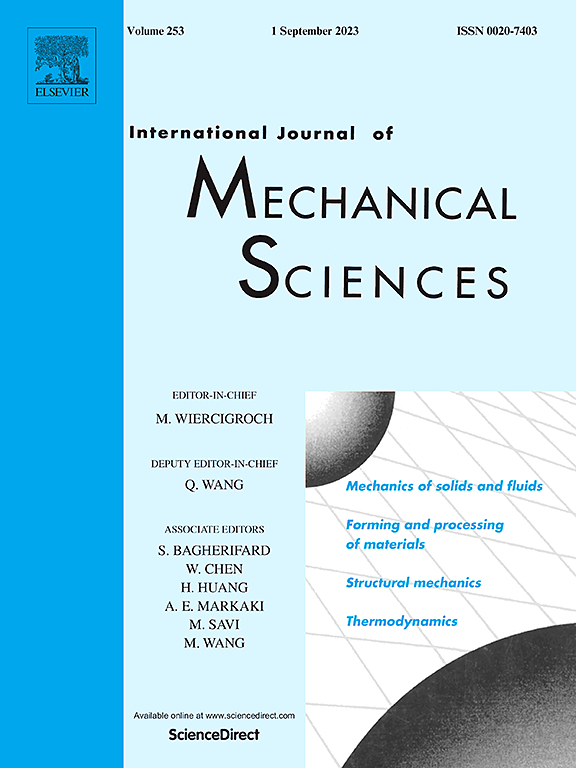Nonlinear multi-field coupling modeling of multilayer-stacked piezoelectric semiconductor structures
IF 7.1
1区 工程技术
Q1 ENGINEERING, MECHANICAL
International Journal of Mechanical Sciences
Pub Date : 2025-01-28
DOI:10.1016/j.ijmecsci.2025.110025
引用次数: 0
Abstract
Multilayer-stacked piezoelectric semiconductor (MSPS) structures hold great promise as building blocks for advanced multi-functional semiconductor devices, particularly in the field of flexible electronic devices. Existing theoretical models often consider either geometrical or physical nonlinearity individually, while practical engineering applications frequently involve both. This study presents a two-dimensional (2-D) thermo-deformation-polarization-carrier (TDPC) coupling plate model for MSPS structures, incorporating both geometrical and physical nonlinearities, which is a general model that is applicable for analyzing the nonlinear multi-field coupling mechanical behavior of various complex layered structures. The derived plate model includes two parts: the zeroth-order equations that describe in-plane extensional deformations and the first-order equations that address out-of-plane flexural deformations. Validation against three-dimensional (3-D) finite element results conforms the accuracy of the proposed TDPC coupling plate model. Using this model, we examine the multi-field coupling mechanical responses of an n-type sandwich-like MSPS (S-MSPS) plate under various loading conditions, including individual mechanical or thermal loads and combined mechanical-thermal loads. The numerical results reveal the tuning effect of different loads on the multi-field coupling behaviors of S-MSPS structures. This study provides a theoretical foundation for the development of MSPS-based devices in the future.求助全文
约1分钟内获得全文
求助全文
来源期刊

International Journal of Mechanical Sciences
工程技术-工程:机械
CiteScore
12.80
自引率
17.80%
发文量
769
审稿时长
19 days
期刊介绍:
The International Journal of Mechanical Sciences (IJMS) serves as a global platform for the publication and dissemination of original research that contributes to a deeper scientific understanding of the fundamental disciplines within mechanical, civil, and material engineering.
The primary focus of IJMS is to showcase innovative and ground-breaking work that utilizes analytical and computational modeling techniques, such as Finite Element Method (FEM), Boundary Element Method (BEM), and mesh-free methods, among others. These modeling methods are applied to diverse fields including rigid-body mechanics (e.g., dynamics, vibration, stability), structural mechanics, metal forming, advanced materials (e.g., metals, composites, cellular, smart) behavior and applications, impact mechanics, strain localization, and other nonlinear effects (e.g., large deflections, plasticity, fracture).
Additionally, IJMS covers the realms of fluid mechanics (both external and internal flows), tribology, thermodynamics, and materials processing. These subjects collectively form the core of the journal's content.
In summary, IJMS provides a prestigious platform for researchers to present their original contributions, shedding light on analytical and computational modeling methods in various areas of mechanical engineering, as well as exploring the behavior and application of advanced materials, fluid mechanics, thermodynamics, and materials processing.
 求助内容:
求助内容: 应助结果提醒方式:
应助结果提醒方式:


